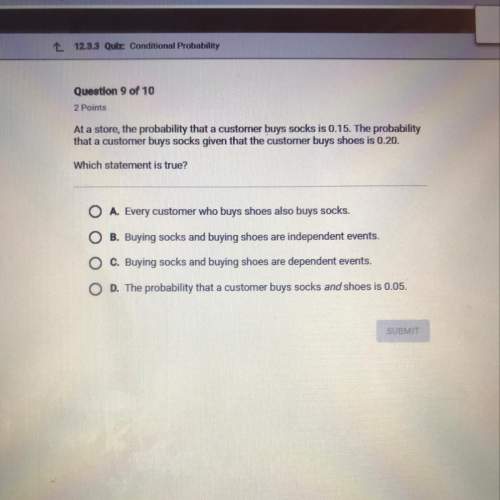
Mathematics, 15.04.2020 20:09 nsg0686
The dot plots below show rainfall totals in the Highlands and Lowlands areas of a certain region.
2 dot plots with number lines going from 2 to 32 in increments of 2. A dot plot titled Highlands. There are 2 dots above 2, 3 above 4, 2 above 6, 3 above 8, 4 above 10, 3 above 12, 4 above 14, 5 above 16, 5 above 18, 4 above 20, 2 above 22, 1 above 24, 2 above 26, 2 above 28, 1 above 30 and 1 above 32. A dot plot titled Lowlands. There are 3 dots above 2, 5 above 4, 3 above 6, 3 above 8, 5 above 10, 7 above 12, 6 above 14, 4 above 16, 2 above 18, 1 above 20, 2 above 22, 1 above 24, 0 above 26, 2 above 28, and 0 above 30 and 32.
Which statement comparing the shapes of the dot plots is true?
Both the Highlands and the Lowlands data points are evenly distributed around the center.
Both the Highlands and the Lowlands data points are clustered toward the left of the plot.
The Highlands data points are evenly distributed around the center, while the Lowlands data points are clustered toward the left of the plot.
The Highlands data points are clustered toward the left of the plot, while the Lowlands data points are evenly distributed.

Answers: 1
Another question on Mathematics

Mathematics, 21.06.2019 16:50
The parabola x = y² - 9 opens: a.)up b.)down c.) right d.)left
Answers: 1

Mathematics, 22.06.2019 00:00
Aspacecraft can attain a stable orbit 300 kilometers above earth if it reaches a velocity of 7.7 kilometers per second. the formula for a rocket's maximum velocity v in kilometers per second is vequalsminus0.0098tplusc ln upper r, where t is the firing time in seconds, c is the velocity of the exhaust in kilometers per second, and r is the ratio of the mass of the rocket filled with fuel to the mass of the rocket without fuel. find the velocity of a spacecraft whose booster rocket has a mass ratio of 20, an exhaust velocity of 2.1 km/s, and a firing time of 15 s. can the spacecraft achieve a stable orbit 300 km above earth?
Answers: 3

Mathematics, 22.06.2019 00:20
Submarines control how much they float or sink in the ocean by changing the volume of air and water contained in large ballast tanks. when the tanks are completely full of water, the submarine increases its overall mass and sinks down to the bottom. when the tanks are completely full of air, the submarine reduces its overall mass and floats to the surface. depending on the density of the seawater surrounding the submarine, it will pump seawater in or out of the tanks in order to achieve the same overall density as the sea water and float neutrally in the water. the volume of the submarine never changes. when the tanks are completely full of water, a submarine with a volume of 7.8\times10^3\text{ m}^37.8×10 3 m 3 7, point, 8, times, 10, start superscript, 3, end superscript, space, m, start superscript, 3, end superscript has a total mass of 8\times10^6\text{ kg}8×10 6 kg8, times, 10, start superscript, 6, end superscript, space, k, g. the density of the seawater is 10^3\text{ kg/m}^310 3 kg/m 3 10, start superscript, 3, end superscript, space, k, g, slash, m, start superscript, 3, end superscript. to make that submarine float neutrally, and neither float nor sink in the ocean, what volume of water does that submarine need to subtract from its tanks?
Answers: 1

You know the right answer?
The dot plots below show rainfall totals in the Highlands and Lowlands areas of a certain region.
Questions


Mathematics, 14.04.2021 19:30

Mathematics, 14.04.2021 19:30




Mathematics, 14.04.2021 19:30

Mathematics, 14.04.2021 19:30





Mathematics, 14.04.2021 19:30


Social Studies, 14.04.2021 19:30


English, 14.04.2021 19:30






